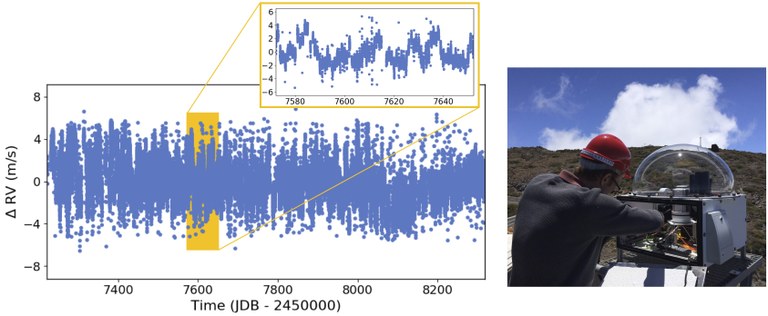HARPS-N Solar Telescope Data Release
Data release date: 18 July, 2020
The HARPS-N Solar Telescope has been observing the Sun as a distant, point-like star every clear day at 5-minute cadence since 18 July 2015 (Dumusque et al., 2015 ApJL, 814, 2, id. L21; Phillips, Glenday et al., 2016, SPIE, 9912, id. 99126Z). HARPS-N/TNG and the small Solar Telescope deliver long-term stable, precise radial-velocity measurements at the sub-m/s level (Cosentino et al., 2012, 8446, article id. 84461V). This is a unique dataset to examine the physical processes that drive intrinsic stellar radial-velocity variations (Collier Cameron, Mortier et al., 2019, MNRAS, 487, 1082; Milbourne, Haywood et al., 2019, ApJ, 874, 107).
Reaching and surpassing the 10 cm/s barrier requires open, international, and cross-disciplinary collaboration. Understanding the Sun via high-resolution, stable Sun-as-a-star measurements is a crucial step towards this goal.
In this spirit, we announce the public release of the first 3 years of this dataset on 18 July 2020. Subsequent data releases will be made annually. The data will be accessible via the Data & Analysis Centre for Exoplanets DACE, https://dace.unige.ch/ hosted at the University of Geneva. Data products will include:
- The extracted 2d spectra, wavelength-calibrated in the observer’s rest frame;
- The normalised, merged 1d spectra, rebinned to uniform wavelength increments in the rest frame of the solar-system barycentre;
- The cross-correlation functions against a G2 reference template, in the barycentric frame, and the corresponding bisector span, FWHM, and contrast;
- Velocities corrected for solar barycentric motion and differential extinction;
- Ca II H&K S-Indices.
Alongside the data release we will launch a new exoplanet detection challenge based on solar spectra. Details to follow soon!

Left: Radial-velocity variations of the Sun seen as a star (with no planets). Right: Solar Telescope at the TNG (La Palma, Spain). Photo credit: D. Phillips.
Download/Website: https://dace.unige.ch/dashboard/
Contact: dphillips@cfa.harvard.edu, xavier.dumusque@unige.ch

